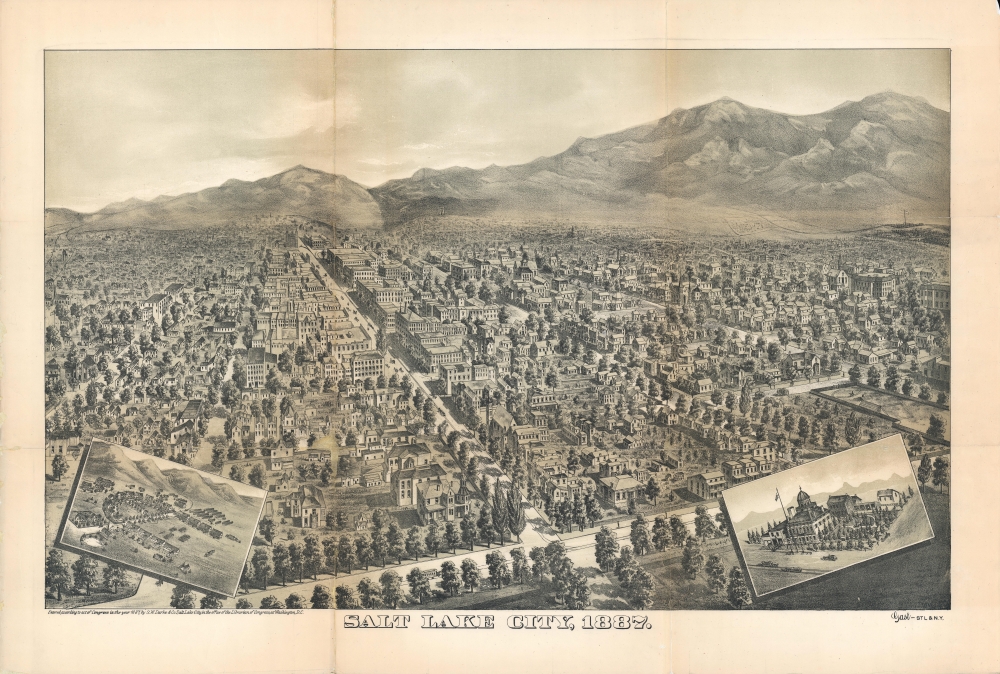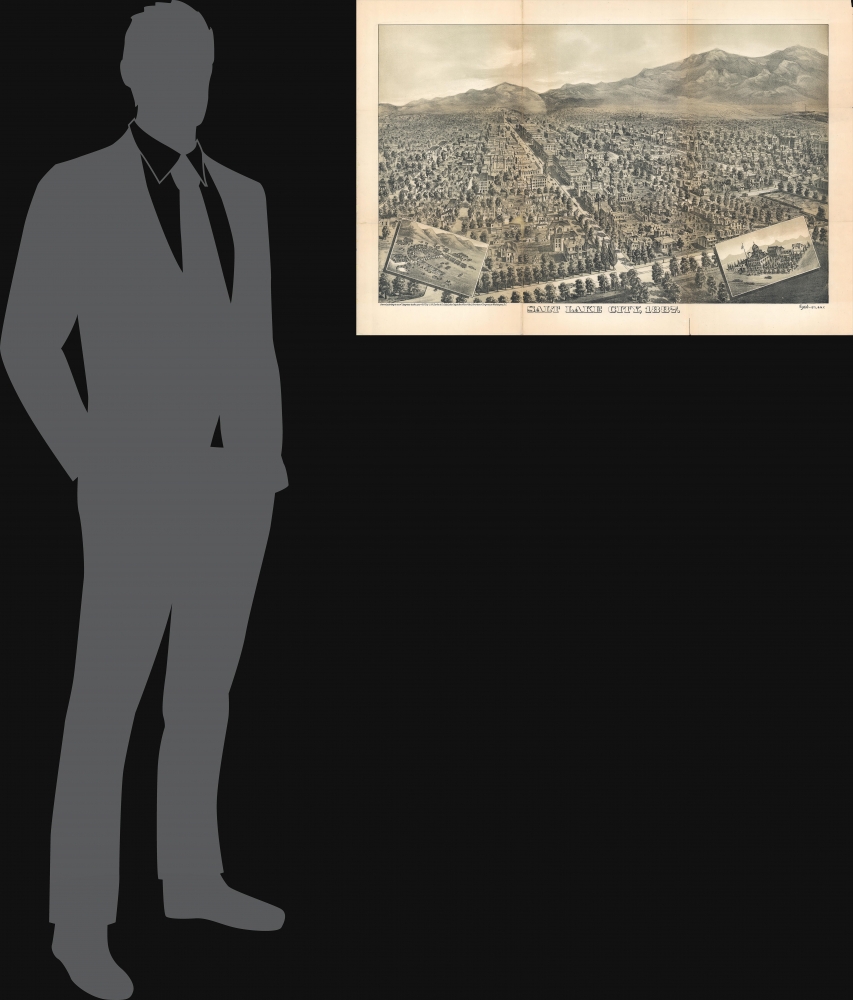1887 Darke / Gast Bird's Eye View of Salt Lake City, Utah
SaltLakeCity-darke-1887
Title
1887 (dated) 23 x 34 in (58.42 x 86.36 cm)
Description
A Closer Look
The view is oriented towards the northeast with the Wasatch Mountains in the background at right. Main St., with the Salt Lake Temple near its terminus, is highlighted. The temple took nearly forty years to construct and is displayed here as nearly completed in the background at left-center, along with the adjoining Salt Lake Tabernacle. A streetcar network centered on Main St. is visible; at the time these were mule-pulled cars, but electrified streetcars were introduced in the years following this view's publication.Rail lines belonging to the Union Pacific trail off in the background at far left towards Ogden, near where the Transcontinental Railroad was completed in 1869. While already a considerable town by 1869, the completion of the railroad and a corresponding mining boom attracted new money and migrants to Salt Lake City, quickly transforming it into the thriving city seen here.
The inset at bottom-left is Fort Douglass, built during the American Civil War (1861 - 1865) and used to secure U.S. government control of the area in the wake of the Utah War (1857 - 1858), as well as to protect the Central Overland Route. The fort can be seen in the main view on a hilltop in the background at right, land that was later turned over to the University of Utah. The inset at bottom-right is the Salt Lake City Council Hall, or simply City Hall.
American Bird's-Eye City Views
The Bird's-Eye view industry emerged in the United States in the middle part of the 19th century and coincided with the commercial development of lithographic printing. Before the rise of lithography, the ability to own and display artwork in the home was largely limited to the extremely wealthy, but the advent of lithographic printing made it possible for everyone to own visually striking artwork. A robust trade developed in portraits of political leaders, allegorical and religious images, and city views.City views were being produced in the United States as early as the 1830s, but the genre exploded after the American Civil War (1861 - 1865). Bridging the gap between maps and pictures, most 19th century American bird's-eye views presented cities to the public from highpoints. Some were imagined, but others were drawn from hot-air balloons or nearby hills. The presentation, combining high elevation, commercial interest, and new printing technology created a uniquely American artform, as described by historian Donald Karshan,
Some print connoisseurs believe that it was only with the advent of the full-blown city-view lithograph that American printmaking reached its first plateau of originality, making a historical contribution to the graphic arts. They cite the differences between the European city-view prints and the expansive American version that reflects a new land and a new attitude toward the land.The vogue for bird's-eye city views lasted from about 1845 to 1920, during which period some 2,400 cities were thus portrayed, some multiple times. Although views were produced in many urban centers, the nexus of view production in the United States was Milwaukee, Wisconsin. The major American viewmakers were Stoner, Wellge, Bailey, Fowler, Hill Ruger, Koch, Burleigh, Norris, and Morse, among others.
Publication History and Census
This view was prepared by S.W. Darke and Company in 1887 and lithographed by August Gast. It was included in Darke's guidebook Salt Lake City Illustrated. Little is known about Darke and Co. aside from this guidebook. The view is sometimes attributed to artist August Koch, due to stylistic similarities, but the name does not appear here. The view is independently cataloged among the institutional holdings of the University of California Berkeley, the Library of Congress, Brigham Young University, the Denver Public Library, the University of Utah, and Southern Methodist University, while the entire 1887 edition of Darke's Salt Lake City Illustrated is held by some fifteen institutions in the United States.Cartographer
August Gast (c. 1892 - 1900) was a printer and publisher active in St. Louis and New York in the late 19th century. Gast, though stylizing himself as a "map publisher" was mostly focused on bank note and revenue stamp lithography. Gast's business took off in 1893 when the Revenue Act of March 3 1883 repealed the two cent tax on checks and drafts. Consequently check and other bank notes no longer required an affixed revenue stamps, however, the public, familiar with such, proved suspicious of any such document that did not bear a official stamp. Thus a flourishing publishing business emerged in which bank and other documents were printed with semi-official "tax" stamps. Gast was one of the most prominent such publishers active in both New York and the Midwest. More by this mapmaker...




